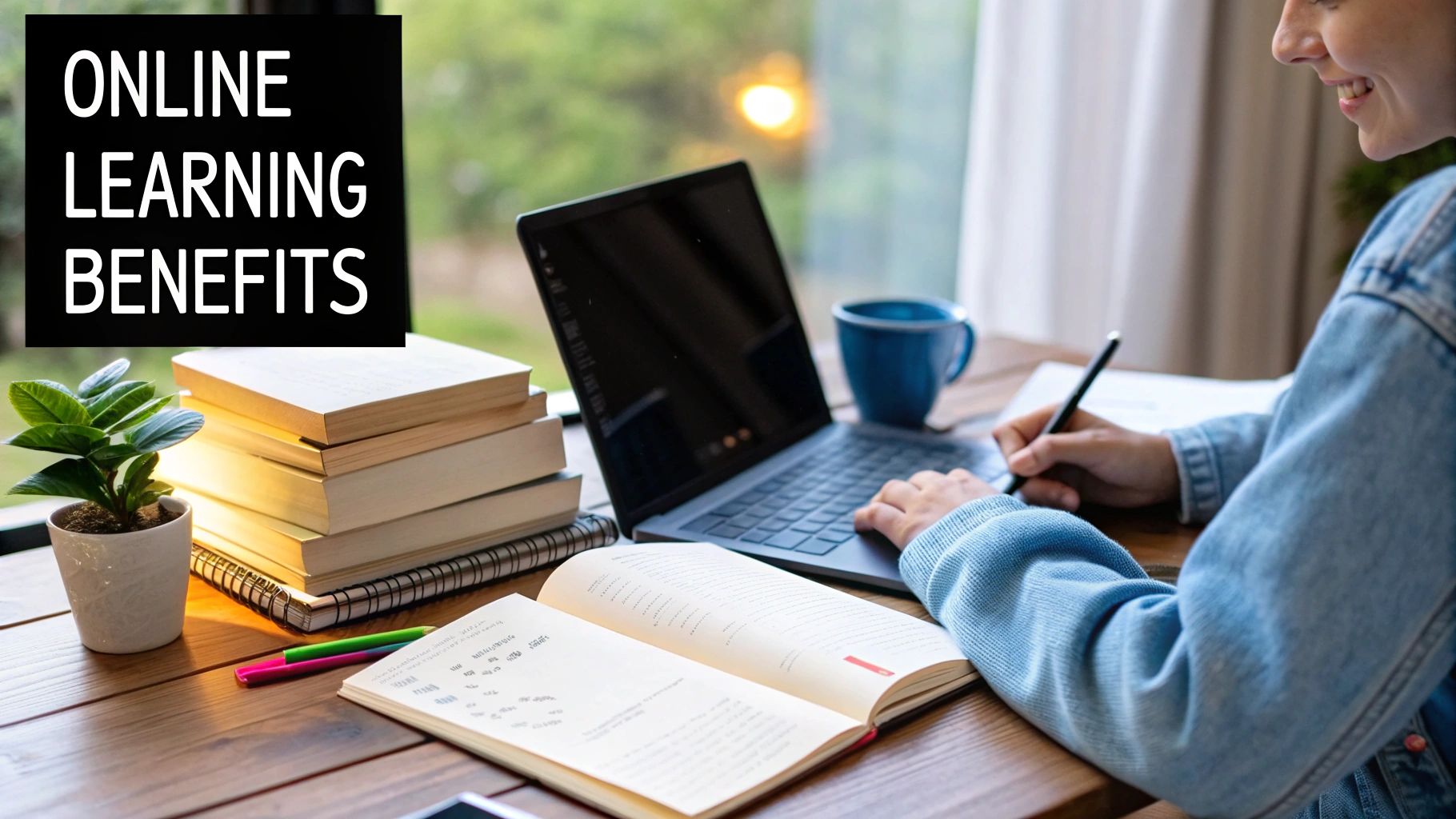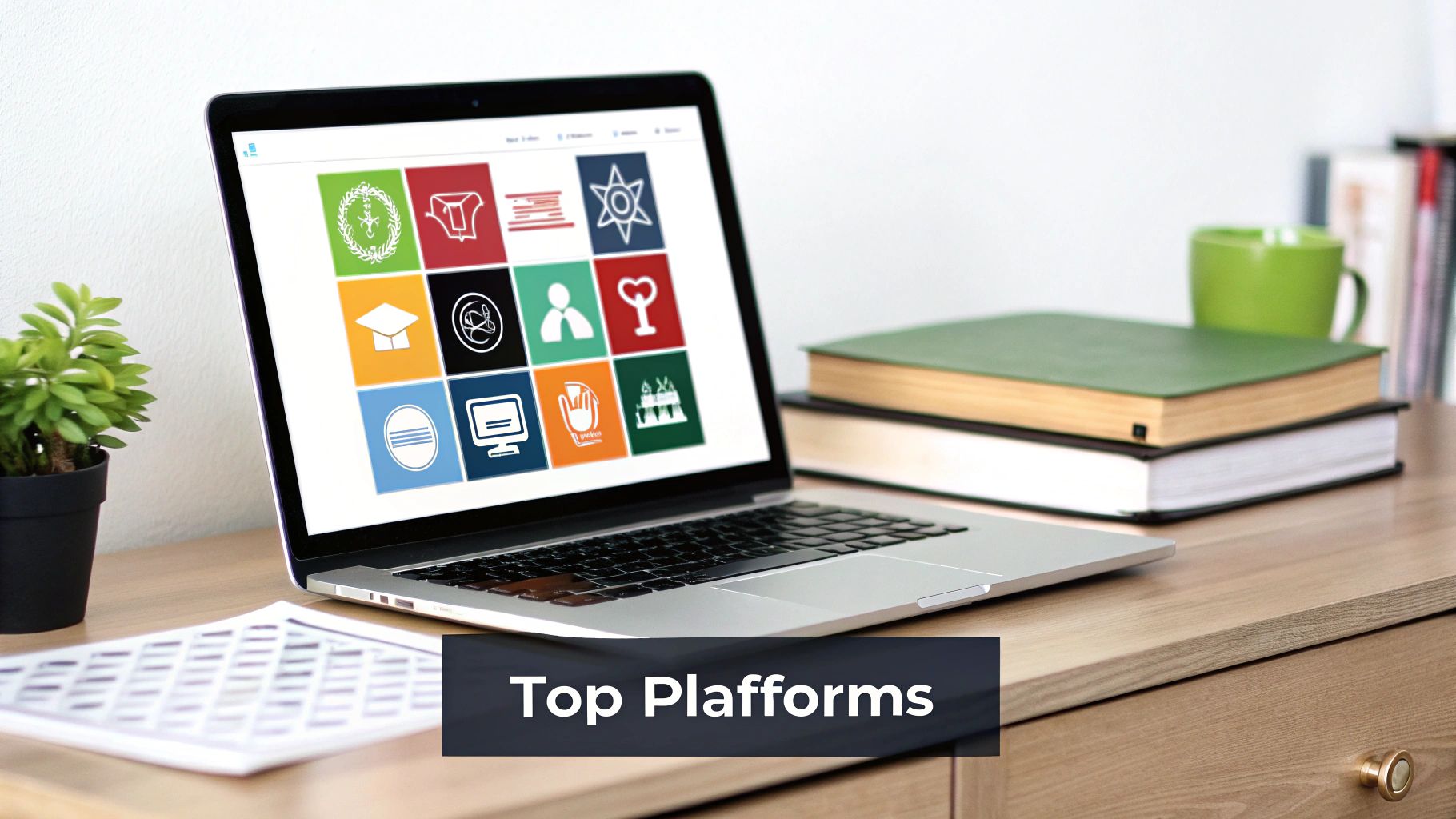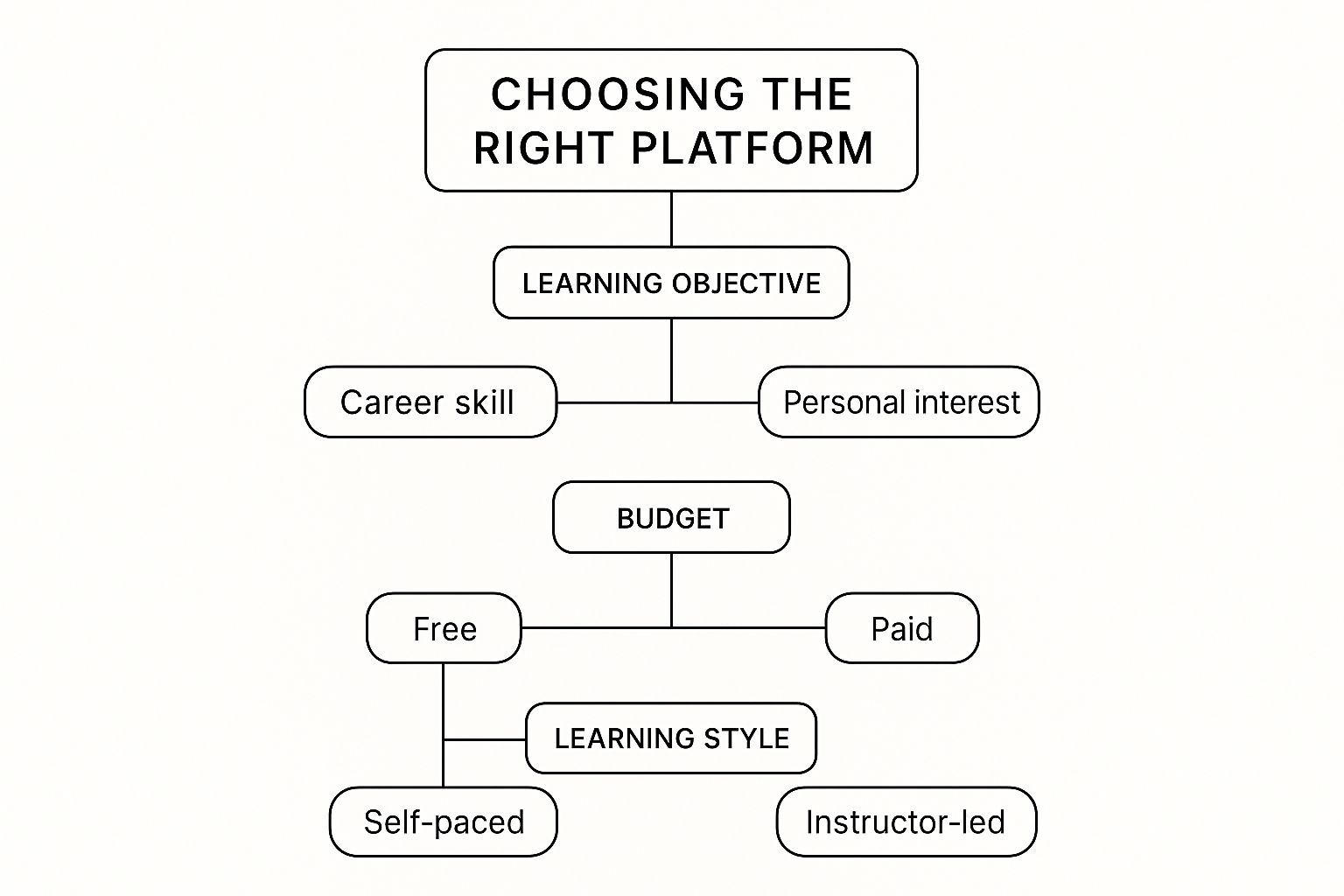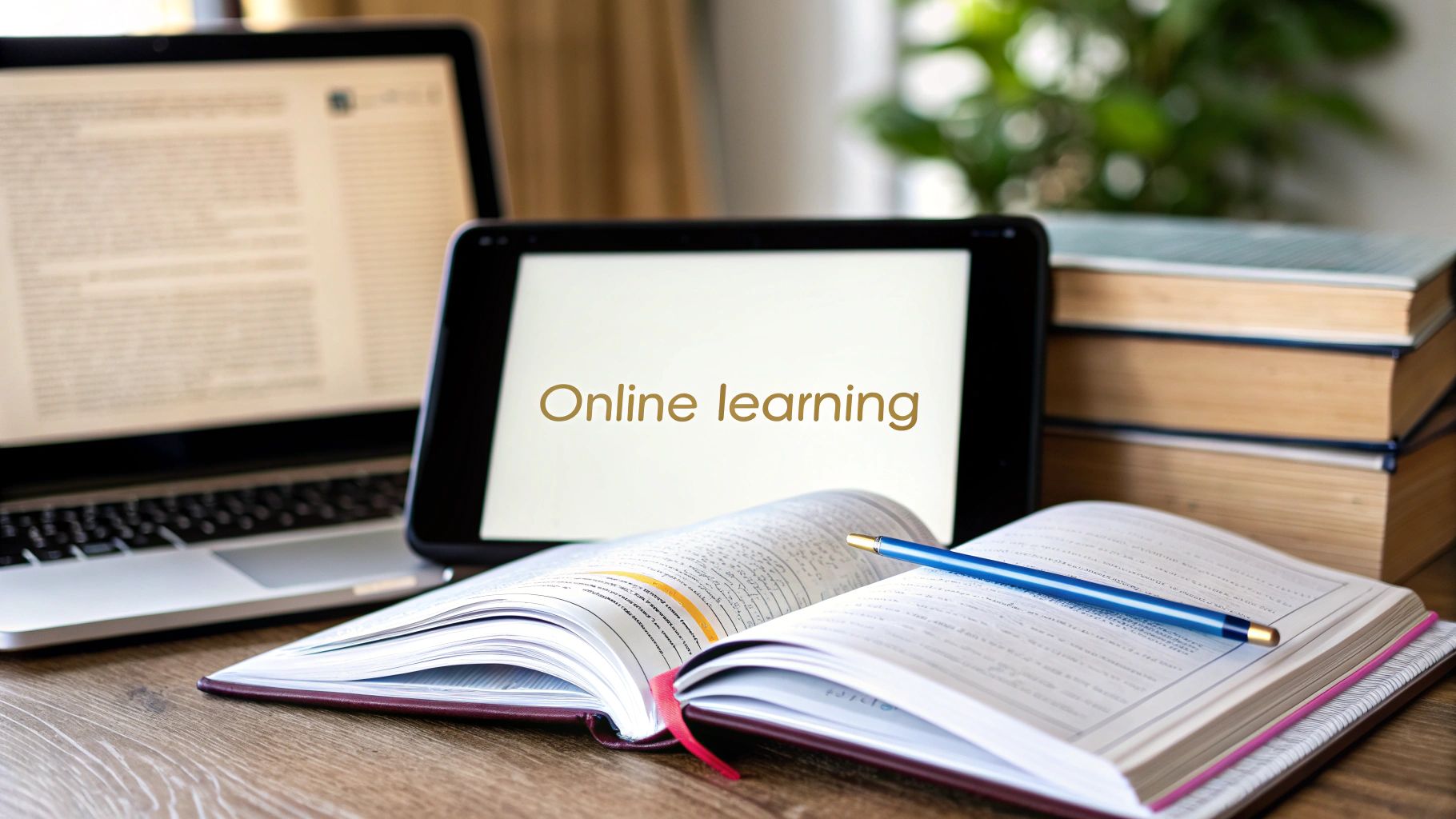Choosing the right online learning platform for your child can feel like an enormous task, filled with hope and a little bit of fear. But really, it’s about finding a space where they feel seen, supported, and genuinely excited to learn. The best choice isn’t just a piece of software; it’s a true partner in your child’s education, one that nurtures their unique spark and builds their confidence day by day, making you feel you’ve made the best possible decision for their future.
Your Child’s New Classroom: Navigating Online Learning

For many families, the classroom has moved to the kitchen table, and with that shift comes a flood of new questions and worries. This search is about more than finding a digital textbook. It’s an emotional journey to find a community where your child can flourish, replacing the uncertainty of a new routine with the comfort of supportive teachers and engaging lessons that make them feel capable and bright.
Ultimately, this is a decision that puts your child’s happiness and academic growth front and centre. It’s about picturing them logging in with genuine curiosity, not dread. You want to see their face light up when they finally grasp a tricky concept because their teacher took that extra moment to explain it in a way that just clicked for them. That feeling of relief and pride, for both of you, is what this search is all about.
Understanding Today’s Educational Shift
What was once a niche option has now become a mainstream path for many families. This isn’t just a fleeting trend; it represents a fundamental change in how we view education. The numbers paint a clear picture. In the UK, a profound shift has occurred, with 77% of learners now believing remote education can be just as effective as traditional methods.
This growing confidence is further reflected in the fact that over 126,000 children in England were homeschooled in the 2022–23 academic year—an increase of more than 10,000 from the previous year. This change means you have more high-quality choices than ever before, but it also means cutting through the marketing noise to focus on what truly matters for your child’s well-being and their precious love of learning.
The goal isn’t just to find an online school. It’s to find your child’s school—a place that adapts to their needs, celebrates their progress, and makes them feel like they belong, even through a screen.
Focusing on What Matters Most
To start this journey with confidence, it helps to know what to look for. The best online learning platforms all share a few core elements that directly impact a child’s experience. To get you started, here is a quick guide to the most important factors to consider, always keeping your child’s needs at heart.
Quick Guide to Key Platform Features
| Feature | Why It Matters for Your Child | What to Look For |
|---|---|---|
| Curriculum Quality | A well-structured curriculum ensures your child is challenged but not overwhelmed, preventing the frustration that can shut down a love for learning. | Look for alignment with national standards (like the UK National Curriculum), clear learning objectives, and a variety of subjects to spark their interest. |
| Live, Interactive Teaching | Real-time lessons with specialist teachers prevent the loneliness of passive learning and keep your child feeling connected and accountable. | Prioritise schools with small class sizes, camera-on policies, and timetabled live lessons, not just pre-recorded videos that can feel impersonal. |
| Accreditation | Official accreditation from bodies like the Department for Education (DfE) gives you peace of mind that their hard work will be recognised. | Check for Ofsted reports or accreditation from recognised educational bodies to ensure the school meets rigorous standards. |
| Student Support & Well-being | Academic success is tied to emotional well-being. A supportive environment where your child feels safe to ask questions is non-negotiable. | Ask about pastoral care, mental health resources, anti-bullying policies, and opportunities for one-to-one support when they feel stuck. |
Knowing these key pillars will help you cut through the noise and evaluate each platform based on what will genuinely help your child thrive.
Here are the foundational pillars of a great online school:
- A Nurturing Environment: Does the platform prioritise student well-being? Think about your child feeling anxious. Look for small class sizes, strong anti-bullying policies, and a culture of encouragement that builds them up.
- Engaging, Live Teaching: Is learning an interactive conversation or a passive lecture? Real-time classes with specialist teachers who can answer your child’s unique questions and give immediate feedback are crucial for keeping them engaged and feeling heard.
- A Supportive Community: Learning online shouldn’t feel lonely. A platform with clubs, collaborative projects, and social events helps children build friendships and feel connected to their peers, easing the worry of social isolation.
As children spend more time in their new online classroom, protecting their eyes from digital strain is also important. It’s worth considering the benefits of using blue light blocking glasses for kids to help make their learning experience more comfortable.
What a Great Online Curriculum Really Looks Like

When you picture your child’s education, you probably imagine a classroom humming with discovery and those wonderful “aha!” moments. But how does that translate to a screen? A truly great online curriculum is so much more than a digital textbook or a playlist of pre-recorded videos. It should feel like an interactive adventure that pulls your child in, not one that passively lectures at them and leaves them feeling bored.
The difference is palpable. It’s the feeling a child gets when they aren’t just reading about Roman history but are challenged to design a virtual aqueduct. It’s the thrill of finally understanding physics not by memorising formulas, but by building a digital trebuchet and seeing the laws of motion in action. This hands-on, “learning by doing” approach is what separates the very best online platforms from the rest, turning screen time into genuine discovery time.
This kind of active engagement transforms subjects that might seem daunting, like algebra or chemistry, into exciting puzzles to be solved. When a platform gets this right, it taps into a child’s natural curiosity and makes them an active architect of their own education, giving them a sense of control and accomplishment.
Moving Beyond Rote Memorisation
At its heart, an excellent online curriculum is committed to deep understanding over simple memorisation. It’s built to spark genuine curiosity and develop critical thinking skills. Imagine your child not just naming the parts of a plant, but running a simulation where they must adjust sunlight and water levels to help it flourish. That is the kind of learning that sticks and makes them feel clever and capable.
To spot this quality, look for curriculums that champion:
- Project-Based Learning: For example, instead of just writing a report on renewable energy, a child might be tasked with designing a wind turbine for a specific location, considering geography and physics. This makes learning feel real and important.
- Interactive Simulations: These fantastic tools let children explore scientific principles or historical events in a safe, controlled digital space where they can experiment and see cause and effect for themselves.
- Gamified Challenges: Points, badges, and leaderboards can turn mastering multiplication tables or learning new vocabulary into a fun and motivating game, reducing the anxiety often associated with these tasks.
When these elements come together, learning becomes relevant and purposeful. Your child sees why they are learning something, which is a powerful motivator that nurtures a true love for learning, not just a knack for passing tests.
A great curriculum doesn’t just ask, “What do you know?” It asks, “What can you do with what you know?” This shift from passive reception to active creation is the key to unlocking your child’s potential.
Aligning with UK Educational Standards
For parents in the UK, one of the biggest concerns is making sure an online curriculum meets national standards. You want the freedom of online learning without sacrificing the academic rigour and recognition that comes with a traditional education. The best online schools make this completely transparent.
Look for clear evidence that the curriculum is aligned with frameworks like the UK National Curriculum, leading to recognised qualifications such as GCSEs and A-Levels. Reputable platforms will be upfront about this, often detailing exactly how their courses map to these standards. Accreditation from bodies like the Department for Education (DfE) or being a registered examination centre (like a Pearson Approved Centre) adds an essential layer of assurance, calming any parental anxieties about their child falling behind.
This alignment ensures your child isn’t just having fun but is also building a solid academic foundation that will be recognised by universities and future employers. It gives you peace of mind, knowing their hard work will open doors. You can discover more about what sets apart the top educational options by exploring our detailed guide to the best online education platforms available today.
Ultimately, the goal is to find a platform that strikes the perfect balance. It must be engaging enough to capture your child’s imagination while being structured enough to deliver a world-class education that prepares them for success, wherever their journey takes them.
The Human Connection in Digital Education

Learning online should never mean learning alone. Behind every screen is a child who needs to feel seen, heard, and genuinely supported. Their confidence, motivation, and even their willingness to tackle tricky subjects are all deeply tied to this sense of human connection. When you’re comparing online learning platforms, you’re not just buying access to software; you’re choosing a community for your child, a place where they feel they truly belong.
It’s the difference between watching a pre-recorded cooking show and taking a live, interactive cooking class. In one, you’re just a passive observer. In the other, the chef knows your name, answers your questions in real-time, and notices when you need a little extra help. That’s the energy you should be looking for in an online school—that feeling of personal care that lets your child know they matter.
This focus on human interaction is what turns a digital service into a vibrant, living classroom. Honestly, your child’s well-being depends on it.
What Real Student Support Looks Like
True student support goes far beyond a technical helpdesk. It’s about creating a safety net of people who are genuinely invested in your child’s success and happiness. This support system should be woven into the very fabric of the school, visible in everyday interactions.
Imagine your child is struggling with trigonometry. One platform might offer a library of help articles. A truly supportive platform, however, provides access to a one-to-one mentoring session with a subject specialist who can patiently work through the problem with them until it clicks. That single moment of personalised attention can be the difference between your child giving up in frustration and feeling a surge of academic confidence.
This human-first approach is becoming a key differentiator in a crowded market. With the UK’s e-learning sector forecast to grow by an incredible USD 12.66 billion between 2025 and 2029, platforms must offer more than just content to stand out. As technology advances, the most successful schools will be those that use it to deepen, not replace, the essential student-teacher bond. You can discover more insights about this growth in the full e-learning market report.
The Power of a Live Classroom
The heart of any real connection in an online school is the live classroom. This is where your child isn’t just a username in a system, but an active participant in their own education, with a face and a voice.
A pre-recorded video can’t pause to ask your child if they understand. It can’t see the spark of curiosity in their eyes or the flicker of confusion that needs addressing right away. A qualified teacher in a live, interactive lesson can do all of that and more.
The magic happens when a teacher says, “That’s a great question, Sam, let’s explore that,” or “Jasmine, I can see you’ve worked hard on this, let’s look at step three together.” These are the moments that make a child feel valued and understood, fuelling their desire to learn and taking away the fear of ‘getting it wrong’.
Look for platforms that prioritise:
- Small Class Sizes: This allows teachers to give individual attention and ensures no child gets lost in the crowd or feels too shy to speak up.
- Camera-On Policies: Seeing faces builds rapport and helps teachers gauge understanding and engagement, making the class feel like a real community.
- Interactive Tools: Features like virtual whiteboards, polls, and breakout rooms encourage active participation, not just passive watching.
This kind of environment fosters a sense of belonging and accountability that is vital for a child’s growth.
More Than Just Academics: Pastoral Care and Community
A child’s emotional well-being is the foundation upon which all academic achievement is built. The best online learning platforms understand this and make pastoral care a top priority. This is the support that looks after the whole child, not just their grades.
Think of it as the digital equivalent of a friendly form tutor or a school counsellor. It’s about having a designated person who checks in, offers guidance on challenges outside of coursework, and promotes a positive and kind school culture. This is crucial for building an inclusive atmosphere where every child feels safe and respected. For example, knowing there is a clear anti-bullying policy and a specific person to talk to can ease a parent’s deepest worries. If you want to dive deeper into this topic, you can learn more about what inclusion in schools truly means and why it’s so important.
Furthermore, learning shouldn’t be a solitary activity. Great platforms create opportunities for social connection through:
- Collaborative Projects: Students work together in small groups to solve problems, developing essential teamwork and communication skills.
- Virtual Clubs: From chess and coding to debate and art, clubs allow children to bond with peers over shared interests and form real friendships.
- School-Wide Social Events: Online assemblies, spirit weeks, and virtual talent shows build a strong sense of school community and shared fun.
When a platform offers these layers of support, it shows a real commitment to nurturing not just a good student, but a happy, well-rounded, and confident young person.
Matching the Platform to Your Child’s Learning Style
Every child learns differently, and this simple truth should be the compass that guides your search for an online school. You know your child better than anyone. You’ve seen their eyes light up with curiosity and you’ve watched them wrestle with frustration. This is your chance to use that deep, parental insight to find a platform that feels like it was made just for them.
This isn’t about trying to squeeze your child into a pre-made digital box. It’s about finding technology that bends to their personality and natural rhythm. Does your child need the clear, predictable structure of a fixed timetable to feel secure, or do they blossom with the freedom to dive deep into a topic whenever inspiration strikes? Answering that one question is a massive first step.
You are the expert here. Trust your instincts. The goal is to match their personality and learning preferences to a school’s features, ensuring their online education empowers them instead of dictating how they must learn.
Identifying Your Child’s Unique Learning Profile
Think about how your child naturally interacts with the world. Are they always drawing, building, and taking things apart? Or can they remember every word of a story you read to them? These aren’t just quirks; they are vital clues to their preferred learning style. Recognising this helps you cut through the noise and zero in on platforms that truly speak their language.
- The Visual Learner: This child understands the world by seeing it. They are drawn to charts, diagrams, colourful videos, and demonstrations. They’re more likely to say, “Show me how,” rather than, “Tell me how.” A platform that’s heavy on text-based articles with few visuals will feel like a chore for them and drain their enthusiasm.
- The Auditory Learner: This child learns best by listening. They thrive in discussions, absorb information from lectures, and remember things they’ve heard spoken aloud. They get a huge amount from live classes where they can ask questions and hear their teacher and peers explain ideas. A self-paced platform with no live interaction could leave them feeling isolated and uninspired.
- The Kinaesthetic Learner: This is your ‘hands-on’ child who needs to do something to truly learn it. They need to move, build, experiment, and engage their body. For this child, project-based assignments, virtual labs, and interactive simulations are non-negotiable for keeping them from getting fidgety and disengaged.
Imagine a kinaesthetic learner trying to understand ecosystems by just reading about them. It would be a real struggle. Now, picture that same child using a platform that lets them build a balanced virtual terrarium, adjusting variables and seeing the immediate consequences. That is the kind of perfect match you’re looking for, the kind that makes a child feel understood.
Pacing and Structure: The Freedom-Seeker vs. The Routine-Lover
Beyond learning styles, think about your child’s personality and organisational skills. This will point you towards either a synchronous (live, timetabled) or asynchronous (self-paced) learning model.
It’s a delicate balance. A child who thrives on routine might feel lost and anxious with too much freedom, while a self-motivated explorer may feel stifled by a rigid schedule. Neither approach is inherently better; it’s about what works for your child.
Let’s look at two different children to see how this plays out in the real world.
Practical Example 1: Meet Liam, the Routine-Lover
Liam is 11 and does best when he knows exactly what to expect. He likes having a set time for maths, a specific break for lunch, and a clear end to his school day. For a child like Liam, an online school with a fixed, live timetable is ideal. It provides the structure he needs to feel secure and focused. Platforms offering self-paced modules with no set schedule would likely cause him stress and make procrastination a real challenge. He needs the external accountability of a live teacher and classmates waiting for him to feel safe and on track.
Practical Example 2: Meet Aisha, the Freedom-Seeker
Aisha is 14 and loves diving deep into subjects that fascinate her. When she’s passionate about a history project, she wants to spend three hours researching it, not stop because it’s time for science. For Aisha, a fully flexible, self-paced (asynchronous) platform might seem appealing at first glance.
However, the best solution for her is likely a platform that blends structure and flexibility. A school with live, timetabled core lessons combined with ample time for independent projects and club activities would give her the guidance she needs for subjects like maths while allowing her the freedom to explore her passions without feeling restricted or bored.
Understanding this fundamental part of your child’s personality is key. It prevents the heartbreaking scenario where a brilliant child fails to thrive simply because their learning environment works against their natural grain. By putting their needs first, you can choose a platform that feels less like a school and more like a launchpad for their potential.
Your Practical Checklist for Choosing a Platform
Alright, you’ve done the research. You know what makes a good online school tick. Now for the final, most important step: turning all that knowledge into a confident choice for your child. This is where the theory meets reality.
Think of it as the final fitting room before you buy. You need to see how the platform actually feels, not just how it looks on paper. This checklist is designed to walk you through that final evaluation, helping you compare your top choices side-by-side and pick the one where your child will genuinely flourish.
To kick things off, this decision tree can help you quickly filter your options based on what matters most to you—whether that’s learning goals, budget, or your child’s specific learning style.

As the graphic shows, the right platform for you depends entirely on these core decisions. Use it to bring your most suitable options into sharp focus.
Making the Most of Free Trials and Demos
Nearly every reputable online school will offer a free trial or a live demo. Don’t skip this. This is your single best chance to peek behind the curtain and see the school in action, away from the glossy marketing.
Your job here isn’t just to watch—it’s to test-drive it.
- For your child: Let them loose on the platform. Get them to click around the dashboard, try a sample lesson, or see what the student common room looks like. Watch their face. Are they curious and excited? Or do they look overwhelmed and frustrated? That gut reaction speaks volumes and is more valuable than any brochure.
- For you: Treat any demo call like a consultation, not a sales pitch. Go in with a list of specific, targeted questions that address your biggest worries.
Get right to the heart of what matters for your child. For example, you could ask, “My daughter is a very hands-on learner. Can you show me a science project she would do in Year 7?” or “What’s your process when a student starts falling behind in maths? How do you make sure they don’t lose confidence?”
Essential Checks Before You Commit
Before you sign on the dotted line, run through these final checks. This is about making sure the school is not just effective but also safe, transparent, and accountable.
- Verify Accreditation and Inspection Reports: For any UK-based school, you should be able to find their latest Ofsted report. You can also check if they are officially accredited by the Department for Education (DfE). This is your guarantee of quality control and safeguarding.
- Understand Progress Tracking: How will you know how your child is doing? Ask to see exactly how progress is monitored and how that information gets to you. Is there a parent portal with real-time grades and teacher notes? Will you receive regular, detailed reports?
- Read the Fine Print on Pricing: Look past the headline monthly figure. Are there extra fees for exam entries, textbooks, lab kits, or specialist software? Make sure you have a crystal-clear picture of the total cost to avoid future stress.
- Evaluate the Learning Environment: Remember, the “classroom” is now in your home. Ensure your child’s physical setup is conducive to learning and well-being. This means good lighting, an ergonomic chair, and frequent breaks using strategies for reducing eye strain from screen time.
- Review the Behaviour Policy: Ask to see the school’s anti-bullying and behaviour policies. A robust, clearly defined policy is a strong signal that the school is serious about creating a positive and safe learning culture where your child will feel secure.
Doing this homework now prevents nasty surprises later. It’s about starting a partnership with a school that’s built on trust.
Platform Comparison Checklist
To make this even easier, use this simple checklist. It will help you directly compare your top 2-3 choices and see which one truly lines up with your family’s needs.
| Evaluation Criteria | Platform A | Platform B | Platform C |
|---|---|---|---|
| Curriculum & Accreditation | |||
| Teacher Interaction | |||
| Student Support | |||
| Technology & Usability | |||
| Parent Communication | |||
| Total Cost (inc. extras) | |||
| Gut Feeling (Child’s Reaction) |
Once you’ve filled this in, the right choice should become much clearer.
Ultimately, the goal is to find a platform that empowers your child to start taking charge of their own education. As they grow, fostering independence in learning is one of the most valuable skills you can equip them with, and the right online school will be your partner on that journey.
Preparing Your Child for the Future of Learning
Choosing an online learning platform today isn’t just about getting through this year’s curriculum; it’s a real investment in your child’s readiness for tomorrow. The world they’ll step into after finishing school is changing at a dizzying pace, and their education has to give them the tools to keep up. This is about more than just passing exams. It’s about equipping them with the skills and mindset to thrive in a world we can only begin to imagine, and feeling secure in the knowledge you’ve prepared them well.
The most forward-thinking online platforms already get this. They’re moving far beyond static digital textbooks and are embracing technology that makes learning deeply personal and relevant. As we get our children ready for what’s next, it’s worth understanding the bigger picture of the digital transformation in education and how it’s reshaping what a classroom can be.
Adaptive Learning: A Personal Tutor in the Software
Picture a maths lesson that knows the exact moment your child starts to get stuck on fractions. Instead of just moving on, the platform instantly offers a different video, a new practice problem, or a fun challenge to explain the concept in a fresh way. That’s the power of adaptive learning technology.
It essentially creates personalised learning pathways, adjusting the difficulty and content in real-time based on your child’s unique strengths and struggles.
- For the child who’s ahead: The system can serve up more complex problems to keep them challenged and stop boredom from setting in. For instance, if a child masters basic algebra quickly, the platform might automatically introduce them to quadratic equations to keep them engaged.
- For the child who needs a bit more support: It can provide extra resources and foundational exercises to build their confidence before they feel lost or overwhelmed. If they struggle with a specific history concept, it could offer a short animated video explaining it from a different angle.
This technology makes sure that learning is always at that perfect “just right” level of difficulty, maximising their potential while building resilience. It’s like having a dedicated personal tutor built right into the software, ensuring no child is left behind or held back.
Building Future-Proof Skills Today
A truly great education has to go beyond the core academic subjects. The very best online learning platforms are actively teaching the essential skills that will be non-negotiable for your child’s future, no matter what career path they decide to follow.
This focus on practical, future-ready skills is reflected in the massive growth of the UK’s digital education sector. The UK’s online education and training market hit a staggering £5.0 billion in 2025, a boom fuelled by the widespread adoption of these platforms. This market, largely driven by learning systems that tailor content to what users actually need, shows a clear demand for a more modern approach to education.
The most valuable skills your child can learn are not just what to think, but how to think. A future-focused platform nurtures this above all else, giving them a foundation of confidence for life.
When you’re comparing options, look for platforms that explicitly teach:
- Digital Citizenship: How to act safely, ethically, and responsibly online, giving you peace of mind.
- Critical Thinking: How to analyse information, spot bias, and build a solid argument, so they can navigate a complex world.
- Remote Collaboration: How to work effectively in a team with people from different places and backgrounds, a vital skill for the modern workplace.
By choosing a platform that prioritises these abilities, you’re not just helping your child meet today’s academic standards. You’re giving them a powerful toolkit to confidently navigate and shape their own future.
Frequently Asked Questions About Online Learning
Choosing the right educational path for your child is a huge decision, and it’s completely normal to have questions. In fact, we find that the most engaged parents are the ones who ask the tough “what if” questions. It shows you’re thinking deeply about what’s best for your family.
Let’s walk through some of the most common concerns we hear from parents. Our goal is to give you clear, straightforward answers so you can move forward with total confidence.
How Much Social Interaction Will My Child Really Get?
This is often the first question on every parent’s mind, and for good reason. The worry is that online learning equals isolation. But a high-quality online school isn’t just about academics on a screen; it’s about building a vibrant, supportive community where your child can make real friends.
It’s a common misconception that children are just sitting alone all day. The reality is quite different. The best online platforms are intentionally designed to foster connection through:
- Live, Interactive Classes: These aren’t just one-way lectures. Think small, camera-on classes where children see their friends, raise their hands, join in discussions, and collaborate in real-time. It’s the classroom experience, brought to life online.
- Virtual Clubs and Socials: From art and debating clubs to school-wide virtual assemblies, these activities create relaxed, fun spaces. It’s here that children bond over shared interests and build those genuine, lasting friendships.
- Collaborative Projects: Many assignments are designed for group work. For instance, a group of students might collaborate on a presentation about climate change, learning to communicate, delegate tasks, and solve problems together—all essential teamwork skills that build strong social bonds.
Imagine your child laughing with a classmate in a digital breakout room as they crack a science problem. That’s the kind of meaningful, daily interaction a great online school is built on.
What if My Child Needs Extra Help or Falls Behind?
In a traditional classroom of thirty-plus pupils, it can be incredibly difficult for a quieter child to get the attention they need. Ironically, a well-structured online school can offer more personalised support, not less, easing that deep parental fear that your child might be overlooked.
A great online school doesn’t wait for a child to fail. It uses data and close teacher observation to intervene early, offering support at the very first sign of a struggle. It’s a proactive, not reactive, approach to your child’s success.
The safety net is robust. If a teacher spots a student struggling with a concept during a live lesson, they can step in immediately. Support systems often include one-to-one mentoring with subject specialists, targeted small-group tutorials to reinforce learning, and regular check-ins with a dedicated pastoral lead who looks after your child’s overall wellbeing. This ensures they feel supported both academically and emotionally, every step of the way.
Are Online Qualifications as Respected as Traditional Ones?
Absolutely, and this is a critical point that can cause a lot of anxiety for parents. Reputable online schools in the UK offer the very same qualifications your child would earn at any top mainstream school. They follow the national curriculum, leading to officially recognised GCSEs and A-Levels.
The key is to look for accreditation. For example, being a Pearson Approved Examination Centre means the qualifications are internationally recognised by universities and employers worldwide. While the method of delivery is different, the academic rigour, the curriculum, and the value of the final certificate are identical. Your child’s hard work will be fully and deservedly acknowledged, opening the same doors to their future.
At Queens Online School, we understand that choosing an educational path is one of the most significant decisions you’ll make. We combine live, interactive classes with dedicated pastoral care to ensure every child feels seen, supported, and empowered to succeed. Explore how our accredited British curriculum can fit your family’s needs at https://queensonlineschool.com/.

